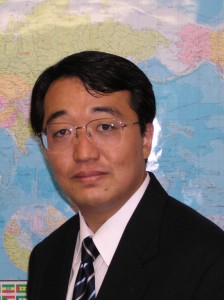緊張と統合:内村鑑三におけるキリスト教と日本の精神
このシリーズでは、私が1994年に執筆した統一神学大学院(Unification Theological Seminary)の神学課程修士論文(Divinity Thesis)を日英二か国語で掲載している。
2.アメリカの宣教師と日本のキリスト教徒の続き
彼らを回心に導いたもう一つの心理学的な要因は、急速な封建制度の崩壊によって、自分達の忠誠の対象を喪失したことである。彼らは公式にその特権を剥奪されたために、新しいエリートとしてのその極端なまでの自意識を、古い儒教的・封建的な範疇の中に見出すことは出来なかった。しかし、だからといって彼らの(侍)日本人としてのアイデンティティーを否定するかのように見える、より普遍的な西洋の価値観を簡単に採用することもできなかった。『主君と家臣』という人格関係を求める侍のメンタリティーは、一朝一夕にして根絶され得なかった。その若い侍達がキリスト教と出会った時、彼らは人格をもった神の概念に深く心を打たれ、やがてそれは彼らの新しい忠誠の対象になったのである。倫理的な見地からみれば、封建的身分関係の崩壊は、またそれに基づく道徳体系の崩壊を意味した。したがって彼らは禁欲的なピューリタニズムを、日本の文化的再構築に貢献するであろう新しい道徳律として、喜んで受け入れたのである。
宣教師達との長期にわたる教育的接触の結果として、多くの学生達がキリスト教に回心した。いくつかの「クリスチャン・バンド」が形成されたが、そのうちの三つはやがて日本のキリスト教発展の中心的役割を演ずる運命にあった。それらは地域にしたがってそれぞれ横浜バンド、熊本バンド、札幌バンドと呼ばれ、最後のグループが無教会運動へと発展して行ったのである。
これら三つのバンドの起源は、その表面的な状況こそ異なってはいるが、ピューリタンの宣教師達と若き日本の侍との相互作用であるという点においては極めて類似している。これらのバンドは全て聖書の教えをキリスト教の基本的な教義として強調し、煩雑な教義や教派間の違いを無視したのである。
B.第二段階:不和の発生と独立の為の戦い
教会の成長に伴って、日本のキリスト教徒達は外国の支配からの完全な独立を望むようになった。この動きには二つの要因があった。一つは西洋の教派主義の弊害であり、もう一つは日本社会に復活し始めたナショナリズムであった。
キリスト教自体がまだまだ日本においては脆弱な状態であったために、日本に来た初期の宣教師達の主な目的は福音を伝播し、日本人の反キリスト教的偏見を取り除くことであった。したがって彼らは教派の違いにはほとんど関心を払わず、西洋における教会の分裂を処女地に持ち込むことは避けるべきであると感じていたのである。さらに宣教師の指導者達は、日本独自の教会を設立する為に尽力した。長老派、改革派、会衆派の教会の21名の宣教師達が、1872年に横浜で開かれた日本プロテスタント宣教師総会に参加した。そこで彼らは、西洋における教派主義を遺憾とし、現存する全ての日本の教会を『日本基督公会』という一つの組織に統一するという文書を起草したのである。
しかし1872年の決議にも関わらず、後に1883年までに生じた教会組織においては、宣教師達から押しつけられた教派的特徴をいつまでも残そうとする傾向があった。そしてそれらは信条と教会組織において西洋の母教会の教派主義的傾向を、型どおりに再現しているように見うけられた。日本における主要教派は、それぞれ一つまたはそれ以上の宣教師団体と提携していて、そこでは外国人が意志決定のプロセスを支配していた。日本人の牧師達は教派が運営する西洋の神学校で教育を受けた。母教会は、日本の信徒達が彼らに従属しなければ、熱心に経済的援助をしようとしなかった。「1883年から1889年までを通じて、日本のプロテスタント教会は、組合教派主義と教会一致へと向かう動きの間の、強い内的緊張によって特色づけられていたのである。」
II. American Missionaries and Japanese Christians (Cont.)
Another psychological drive which pushed them to conversion was the loss of an object for their loyalty, due to the rapid collapse of the feudal institutions. Because they had publicly rejected their heritage, they could not return to Confucian or feudal categories to find meaning for their extreme self-consciousness as the new elite; nor, on the other hand, could they easily adopt the more universal Western values, which to them seemed to deny their identity as (samurai) Japanese. The samurai mentality, which sought for the personal lord-vassal relationship, could not be eradicated so quickly. When the young samurai encountered Christianity, they were struck by the concept of a personal God, which was to become a new object for their loyalty. From an ethical point of view, the collapse of the feudal relationship also meant the collapse of the system of morality based upon it. So, they willingly accepted the ascetic Puritanism as a new code of morality which would contribute to a cultural reconstruction of Japan.(3)
Eventually, a number of students converted to Christianity as a result of their prolonged educational contact with the missionaries. A number of “Christian bands” appeared, three of which were destined to play a central role in the development of Japanese Christianity. They were called the Yokohama Band, the Kumamoto Band, and the Sapporo Band according to their location; the last one was to develop into the Mukyokai movement.
Though the superficial circumstances of their origins differed, the three Bands were quite similar in terms of the interaction between the puritan missionaries and the young Japanese samurai. All three bands emphasized the teaching of the Bible as the basic doctrine of Christianity and ignored dogmatic complexities and denominational differences.
B. Second Phase: Development of Incompatibilities and the Struggle for Independence
As the church grew, the Japanese Christians came to desire complete independence from foreign domination. This impetus had two sources: one is the resistance against the evil of western denominationalism, the other is the resurgent nationalism in Japanese society.
Since Christianity itself was still vulnerable in Japan, the primary interest of the first missionaries to Japan was to spread the Gospel and get rid of the anti-Christian preconception. They were not concerned with denominational difference and felt it irrelevant to import the division of the Church in the West to the virgin island.(4)Further, missionary leaders strived for establishing a uniquely Japanese church. Twenty-one missionaries of the Presbyterian, Reformed, and Congregationalist Churches attended the General Convention of Protestant Missionaries in Japan which met in 1878 at Yokohama. They drafted a document in which western denominationalism was deplored and in which all existing Japanese churches were united into one body to be known as Nippon Kirisuto Kokai or the General Church of Christ in Japan.(5)
In spite of the 1872 resolution, the denominational features imposed by the missionary leadership tended to be sustained by the later emerged religious institutions until 1883, which bear the denominational stamp in creed and polity and of their western prototypes. Each of the major Japanese denomination was associated with one or more missionary organization in which foreigners dominated the decision-making process. Japanese ministers were educated at the denominational seminary in the West. The mother church were not eager to offer financial support for the development of Japanese congregation unless they were affiliated with them. “From 1883 through 1889, the Protestant Church in Japan was wrecked by internal tension between congregational denominationalism on the one hand and the thrust toward national religious unity on the other.”(6)
(3)Caldarola, p.31.
(4)Caldarola, p.33.
(5)Winburn T. Thomas, Protestant Beginnings in Japan: The First Three Decades 1859-1889, (Rutland, Vermont & Tokyo, Japan: Charles E. Tuttle Company, 1959), p.138.
(6)Caldarola, pp.33-34.
